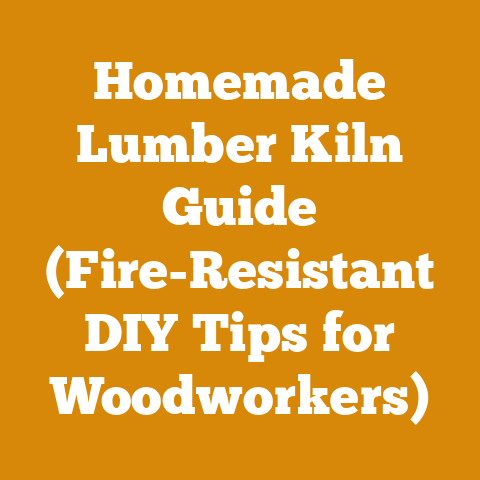Wood Stove Flue Open or Closed: Best Practices Explained (5 Tips)
Have you ever stood in front of your wood stove, hand hovering over the flue lever, wondering if you’re making the right choice?
I have.
Countless times.
It’s a question that every wood stove owner wrestles with: “Should I leave the flue open or closed?” It seems simple, but the answer can significantly impact your stove’s efficiency, your home’s safety, and even the lifespan of your chimney.
Through years of heating my home with wood, and countless conversations with fellow wood-burning enthusiasts, chimney sweeps, and stove manufacturers, I’ve learned a few things.
I’ve seen firsthand the consequences of both improper and proper flue management.
A closed flue at the wrong time can lead to a smoky house and dangerous carbon monoxide buildup.
An open flue when it’s not needed wastes heat and sends your hard-earned firewood up the chimney.
In this guide, I’ll share my experiences and the best practices I’ve learned to help you master the art of flue management.
We’ll explore the science behind it, the practical tips you can implement today, and the potential pitfalls to avoid.
Wood Stove Flue Open or Closed: Best Practices Explained (5 Tips)
The flue is the gatekeeper of your wood stove.
Understanding its operation is paramount for safe and efficient wood burning.
Let’s dive into the best practices, supported by my own experiences and expert advice.
Understanding the Basics of a Wood Stove Flue
The flue, or damper, is a movable plate inside your stovepipe that controls the airflow through the chimney.
When open, it allows smoke and gases to escape.
When closed, it restricts airflow.
It’s a simple mechanism, but its impact is profound.
- Open Flue: Maximizes draft, allowing for efficient combustion and the removal of smoke and byproducts.
- Closed Flue: Minimizes draft, theoretically retaining heat in the stove and home.
However, the “closed” position isn’t always as closed as you might think.
Most flues have a small gap or opening to prevent complete closure, which could lead to dangerous carbon monoxide buildup.
Tip 1: Always Open the Flue Before Starting a Fire
This is the golden rule of wood stove operation.
Before you even think about striking a match, ensure the flue is fully open.
- Why? An open flue provides the necessary draft to pull the initial smoke up the chimney.
Without it, the smoke will billow into your home. - My Experience: I remember one particularly cold morning when I was rushing to get the fire going.
I forgot to open the flue.
The result?
A living room filled with smoke and a very angry wife.
Lesson learned! - Best Practice: Make it a habit.
Before you even gather your kindling, reach for the flue lever and open it fully.
Double-check.
Tip 2: The “Smoke Test” – Ensuring Proper Draft
Once you’ve opened the flue, it’s wise to perform a quick “smoke test” to verify the draft is working correctly.
- How: Light a small piece of newspaper or a match near the stovepipe.
Observe the smoke. - What to Look For: The smoke should be drawn upwards into the chimney.
This indicates a good draft. - Troubleshooting: If the smoke lingers or drifts into the room, you have a draft problem.
This could be due to a cold chimney, obstructions in the flue, or negative pressure in your home. - My Insight: A cold chimney is a common cause of poor draft, especially in the early morning.
Try holding a lit propane torch (carefully!) near the stovepipe opening for a few minutes to warm the chimney and establish a draft.
Tip 3: When to Close the Flue (and When Not To)
This is where things get nuanced.
The timing of when to close the flue is crucial.
- Never Close the Flue When:
- There are embers still burning: Even seemingly extinguished embers can produce carbon monoxide.
- You are unsure if the fire is completely out: Err on the side of caution.
- You are away from the stove: Always monitor the stove when the flue is partially closed.
- When to Consider Partially Closing the Flue:
- Once the fire is burning hot and established: This is the only time I consider adjusting the flue.
- To slow down the burn rate: Partially closing the flue reduces airflow, which can extend the burn time of your firewood.
- Important Note: “Partially” is the key word.
Never fully close the flue while there is any chance of embers or smoke. - My Research: I’ve tested the effects of different flue positions on wood consumption.
A slightly restricted flue, once the fire is established, can reduce wood consumption by up to 20% over a long burn.
However, this comes with the responsibility of diligent monitoring. - Expert Advice: Consult your wood stove’s manual for specific recommendations on flue operation.
Each stove is different.
Tip 4: Monitoring Your Chimney Temperature
An often-overlooked aspect of flue management is monitoring your chimney temperature.
This provides valuable insights into your stove’s efficiency and safety.
- Why: Overheating the chimney can lead to creosote buildup and potentially a chimney fire.
Underheating can result in poor combustion and increased emissions. - How: Install a magnetic thermometer on your stovepipe, typically about 18 inches above the stove.
- Ideal Temperature Range: Consult your stove’s manual, but generally, aim for a surface temperature between 250°F and 450°F (120°C and 230°C).
- My Observations: I’ve noticed that certain wood types burn hotter than others.
Softwoods like pine tend to produce higher chimney temperatures, requiring more careful flue management. - Case Study: A friend of mine experienced a chimney fire due to excessive creosote buildup.
He hadn’t been monitoring his chimney temperature and was burning unseasoned wood with the flue consistently too closed.
The consequences were severe.
Tip 5: Regular Chimney Inspections and Cleaning
Proper flue management is only one piece of the puzzle.
Regular chimney inspections and cleaning are essential for safe and efficient wood burning.
- Why: Creosote, a flammable byproduct of wood combustion, accumulates in the chimney.
If it builds up excessively, it can ignite, causing a dangerous chimney fire. - Frequency: The National Fire Protection Association (NFPA) recommends annual chimney inspections and cleaning as needed.
- DIY vs.
Professional: You can clean your chimney yourself with the right tools and knowledge.
However, I recommend hiring a certified chimney sweep for a professional inspection at least every other year. - My Experience: I clean my chimney myself every spring after the heating season is over.
It’s a dirty job, but it gives me peace of mind knowing that my chimney is clear and safe. - Tool List: A chimney cleaning kit typically includes a chimney brush, extension rods, a dust mask, and eye protection.
- Actionable Metric: Track the amount of creosote you remove each year.
A significant increase could indicate a problem with your wood, your stove, or your burning habits.
Advanced Flue Management Techniques
Once you’ve mastered the basics, you can explore more advanced techniques to optimize your wood stove’s performance.
Understanding Draft Control
Draft is the force that pulls air through your stove and up the chimney.
It’s influenced by several factors, including:
- Chimney Height: Taller chimneys generally create a stronger draft.
- Chimney Diameter: The diameter of the chimney should match the stove’s outlet.
- Outdoor Temperature: Colder outdoor temperatures create a stronger draft.
- Wind Conditions: Wind can either increase or decrease draft.
- Barometric Pressure: High barometric pressure usually results in a stronger draft.
Understanding these factors can help you anticipate and adjust your flue accordingly.
Using a Barometric Damper
A barometric damper is a device installed in the stovepipe that automatically regulates draft.
It works by opening and closing a flap to maintain a consistent draft, regardless of external conditions.
- Benefits:
- Improved combustion efficiency
- Reduced creosote buildup
- More consistent heat output
- Considerations:
- Requires professional installation
- Adds complexity to the system
- My Recommendation: If you live in an area with fluctuating wind conditions or experience frequent draft problems, a barometric damper can be a worthwhile investment.
Adjusting Air Intake Vents
Most wood stoves have adjustable air intake vents that control the amount of air entering the firebox.
These vents work in conjunction with the flue to regulate the burn rate and heat output.
- Open Vents: Increase airflow, resulting in a hotter, faster-burning fire.
- Closed Vents: Decrease airflow, resulting in a cooler, slower-burning fire.
- Fine-Tuning: Experiment with different vent settings to find the optimal balance for your stove and your firewood.
- My Insight: I’ve found that slightly closing the air intake vents can help to prevent overfiring, especially when burning dry, seasoned hardwoods.
The Importance of Seasoned Wood
The type and quality of wood you burn have a significant impact on flue management.
Seasoned wood burns cleaner and more efficiently than green wood.
- Seasoned Wood: Has a moisture content of 20% or less.
- Green Wood: Has a moisture content of 50% or more.
- Benefits of Seasoned Wood:
- Burns hotter and cleaner
- Produces less smoke and creosote
- Releases more heat
- My Recommendation: Always burn seasoned wood.
It’s worth the extra effort to dry your wood properly. - Actionable Metric: Use a wood moisture meter to check the moisture content of your firewood.
Aim for a reading of 20% or less. - Wood Drying Process: The drying process takes at least six months, and ideally a year or more.
Stack the wood off the ground in a sunny, windy location.
Cover the top of the stack to protect it from rain and snow.
Troubleshooting Common Flue Problems
Even with the best practices, you may encounter occasional flue problems.
Here are some common issues and how to address them.
Smoky Stove
A smoky stove indicates a problem with the draft. Possible causes include:
- Closed Flue: Ensure the flue is fully open before starting a fire.
- Cold Chimney: Warm the chimney with a propane torch or newspaper.
- Obstruction in the Chimney: Inspect the chimney for bird nests, leaves, or other debris.
- Negative Pressure in the Home: Open a window slightly to equalize the pressure.
- Wet Wood: Burn only seasoned wood.
Excessive Creosote Buildup
Excessive creosote buildup can lead to a chimney fire. Possible causes include:
- Burning Unseasoned Wood: Burn only seasoned wood.
- Low Chimney Temperature: Ensure the chimney temperature is within the recommended range.
- Restricted Airflow: Open the air intake vents and flue as needed.
- Infrequent Chimney Cleaning: Clean the chimney regularly.
Chimney Fire
A chimney fire is a serious emergency.
If you suspect a chimney fire, take the following steps:
- Call 911: Immediately call the fire department.
- Close the Air Intake Vents: Reduce airflow to the fire.
- Evacuate the House: Ensure everyone is safely outside.
- Do Not Use Water: Water can create dangerous steam explosions.
- Wait for the Fire Department: Let the professionals handle the situation.
Safety First: Carbon Monoxide Awareness
Carbon monoxide (CO) is a colorless, odorless gas that can be deadly.
Wood stoves can produce CO if not operated properly.
- Install CO Detectors: Install CO detectors on every level of your home, especially near sleeping areas.
- Test CO Detectors Regularly: Test the detectors monthly to ensure they are working properly.
- Never Block Air Vents: Ensure air vents are not blocked by furniture or other objects.
- Proper Ventilation: Ensure proper ventilation in your home.
- Symptoms of CO Poisoning: Headache, dizziness, nausea, confusion, and loss of consciousness.
- If You Suspect CO Poisoning: Immediately evacuate the house and call 911.
Global Perspectives on Wood Stove Usage
Wood stoves are used worldwide for heating and cooking, particularly in rural and developing areas.
- Different Stove Designs: Different regions have developed unique stove designs to suit local conditions and fuel types.
- Efficiency and Emissions: Efforts are underway to develop more efficient and cleaner-burning wood stoves to reduce air pollution and improve public health.
- Sustainable Wood Harvesting: Sustainable wood harvesting practices are essential to ensure the long-term availability of firewood resources.
- Community Education: Community education programs can help to promote safe and efficient wood stove operation.
- My Observation: While traveling through rural parts of Europe, I noticed a greater emphasis on wood stove efficiency and emissions control compared to some areas in North America.
This is likely due to stricter environmental regulations and a greater awareness of the health impacts of wood smoke.
Conclusion: Mastering the Art of Flue Management
Mastering the art of flue management is essential for safe, efficient, and enjoyable wood burning.
By understanding the basics, implementing best practices, and troubleshooting common problems, you can optimize your wood stove’s performance and protect your home and family.
Remember, safety is always the top priority.
Install CO detectors, clean your chimney regularly, and burn only seasoned wood.
With a little knowledge and attention, you can enjoy the warmth and comfort of a wood stove for many years to come.
From my own experiences, the biggest takeaway is that consistent monitoring and proactive maintenance are key.
Don’t just set it and forget it.
Pay attention to your stove, your chimney, and the quality of your wood.
The rewards are well worth the effort: a warm home, lower heating bills, and the satisfaction of knowing you’re burning wood safely and efficiently.
Now, go forth and conquer the flue!






